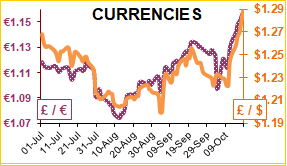The Over the past two weeks, currency has changed rather a lot, possibly something to do with Brexit?
Against the Euro it has lifted 5 cents, and 7 cents against the dollar. November UK wheat futures traded sideways over the last couple of weeks ending week ending at £135.90/T. Another reminder that Brexit and currency effects cannot be underestimated in these markets. Little volume was traded on the November contract, the spread to the more active May 20 contract widened as the what if of trading each side of Brexit continues to create concern and uncertainty. (In a contrary move Defra estimated big crops for both wheat and barley at 16.28 and 8.18 Mln T respectively. The barley crop is the biggest in 30 years and both are expected to have surpluses of around 2 Mln T each. This in a year when Brexit threatens to disrupt the export system both will rely on. Wheat exports for August were 120kt, with 56kt going to the EU. September will be interesting as a desperate move to get exports done pre Brexit has seen news of a logistics nightmare and UK wheat exports having to be covered by purchases from elsewhere to keep up. The only supportive story other than the unpredictable swings of currency seems to be news that in the case of a no deal Brexit there will be import tariffs on Ethanol imports into the UK. The UK imports Ethanol from countries such as the US. So far there has been no sign of change in the UK processors with Ensus often using cheap maize imports over UK wheat and Vivergo still closed. But could this drive the change and open an outlet for the excess wheat we could be left with?
US and European wheat markets remained strong, unlike the UK market, which dipped a week ago, but the physical price has climbed back to unchanged. The US positivity again linked to positive feedback on trade negotiations with China. The USDA report continued to alarm US farmers with a small increase to the large wheat end stock, up 1 Mln T in a month to 287 Mln T. Maize, at 302 Mln T, was slightly reduced but the drop was less than the trade had expected. It was worth noting that 50% of wheat and 65% of maize stocks are in China. With the weather still out of favour for the maize farmer, it is likely the US maize figure could reduce further. France already announced a reduction in its maize forecast to 12.5 Mln T. However, with our little island so tied up in our own politics we have not yet seen are markets gain any support.
The WASDE report reduced soya beans to 96 Mln T, with 20% of soya beans being held in China. This supported bean price as the 2.2 Mln T drop in the production figure was more than the trade had predicted. Yield reductions caused a large proportion of the downgrade. US soya bean end stocks also took a much needed cut of nearly 5 Mln T. This was enough to turn some traders bullish as the global soya bean balance sheet tightened for the first time in a long season dominated by the trade dispute. The trade dispute was not completely forgotten, as indications of positive progress again provided further support to the market. The Chinese economy is growing more slowly than in recent years, alternative products and supply partners becoming the norm and the pig herd will need time to rebuild, therefore demand from this key market may still be lower than previously seen.
At Humphrey Feeds friendly bacteria are just one of the things we encourage to help your hens be happy, healthy and productive, but today’s story gives that a whole new spin. Research at the University of Copenhagen has suggested that ‘survival of the friendliest’ is more important than ‘survival of the fittest’ for bacteria.
They found that if it benefits the community bacteria move over and make space for each other. They studied thousands of combinations of bacteria over a number of years, and it was clear that cooperation to survive was truer than the traditional Darwinian theory of evolution. After isolating competing bacteria on a small corn husk where they had to fight for space the same bacteria united against threats, like antibiotics, rather than fighting each other. Healthy bacteria produce more bio film, a protective film. But these island communities came together and instead of the strongest outcompeting in biofilm production they allowed space for the weaker bacteria allowing them to grow better than if on their own. They also shared tasks with their neighbours reducing unnecessary work. The bacteria are organised and work together – perhaps picking their nearest partners to complement them like any great team.
This story is interesting for feeding for health and disease prevention in the future. But more than that, we hope that you too, will have the chance to behave like a bacteria this week. Think of those around you and work together. But most importantly if you see someone looking isolated or struggling rally around them and make them part of your team. We are stronger together!
Brought to you by Melanie Blake and Martin Humphrey




















